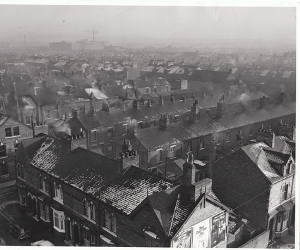Cllr Lisa Trickett, Cabinet Member for Clean Streets, Recycling and Environment at Birmingham City Council, writes about an environmental landmark.
.
Today marks sixty years since the approval of one of the nation’s most significant pieces of legislation – the Clean Air Act. Drawn up after London’s Great Smog of 1952, it went a great way towards solving many of the issues we faced as a post-war heavily industrialised nation.
Fast forward six decades, air quality is still very much a pressing issue. Our modern threat is the proliferation of the motor vehicle and diesel technology, which was promoted by successive governments as a fuel to use, but in recent times rightly raised as a concern due to the levels of nitrogen dioxide and other pollutants it causes.
In simple terms, this is a modern day public health crisis and action is necessary. The government, following legal action by campaigners last year, decided that Birmingham should be amongst a number of cities mandated to introduce a Clean Air Zone by 2020. The zone will not have to apply to private vehicles but will cover the likes of HGVs, buses and taxis that are not compliant.
Scoping work is well underway to devise a scheme that best meets the legislative challenges we face and we will have measures in place by the deadline set.
However, I cannot make it clear enough that Birmingham is NOT a slow responder on this issue. For a number of years we have been working in partnership with academics, technology providers and government agencies to come up with improvements and solutions.
Recently, we began a LPG Taxi retrofit programme and are now up to the tenth black cab to be converted with the Euro 6 solution – the engine emissions standard that will be exempt from any charges in the Clean Air Zone when established.
We have found that by putting in the new LPG replacement engines into vehicles up to 15 years old, that things that had seized up over time have suddenly sprung back into action. Drivers are finding their under-seat heating now works, air conditioning is operational again, and the original horsepower of the vehicles is released. Clearly LPG technology reaches places that other fuelled engines do not. One driver has told us he is so pleased, he feels it has changed his life!
And on the electric vehicle front, through recent success in the Government’s ULEV (Ultra Low Emission Vehicles) programme, six EVs have been introduced to the city council’s own fleet along with charging infrastructure in four key buildings.
This includes fast chargers at Lancaster Circus and the Kenrick Centre to support the Adults and Communities Night care team; two standard chargers at Manor House for the Environmental Services Pest Control Team; a standard charger for the Parks & Nurseries Team at Woodgate Valley Park and a charge unit at a Housing Estates Management Services employee’s home in Longbridge, where he carries out local estate care-taking and housing maintenance services using an EV small van.
This is first step towards transitioning towards low and zero emission green fleets, and will help prove to other employers – large and small – that is genuinely an option for the future.
And finally, if any further proof was needed that Birmingham as a whole takes air quality seriously, recent DfT data* shows that 5,446 plug-in or hydrogen powered vehicles were registered in the first quarter of 2016 in Birmingham – only just behind the 6,094 across all London boroughs. Nationally, the rate is approximately one in every 500 vehicles.
There is still a lot to do, we’ve made early progress, but as we reflect on the 60 anniversary of the Clean Air Act, one thing is for sure: we can’t afford to be complacent on air quality and here in Birmingham our recent work is clear evidence we won’t be in the weeks, months and years ahead.
